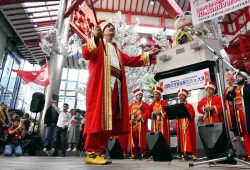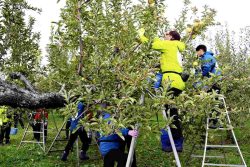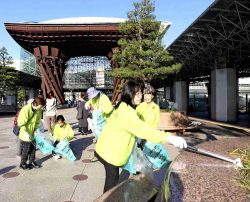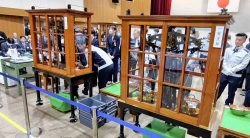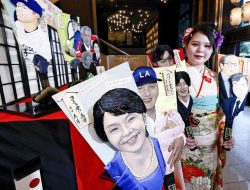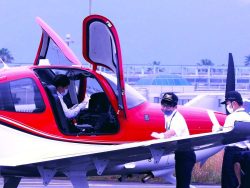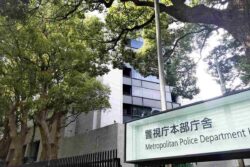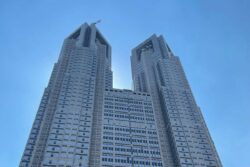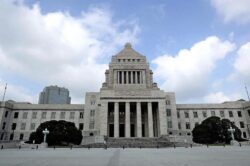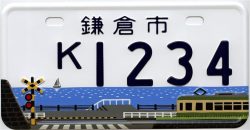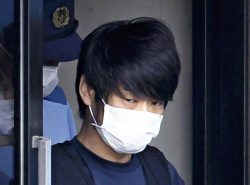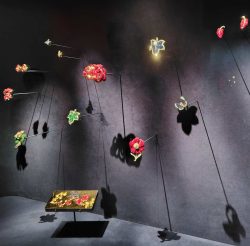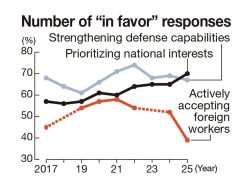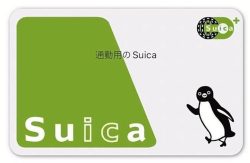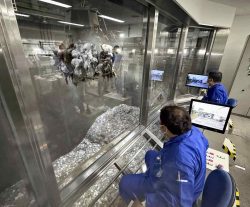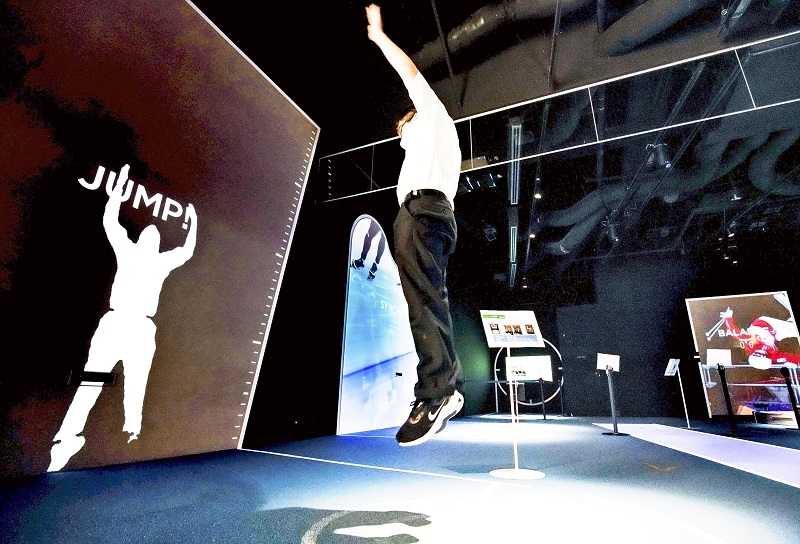
A visitor matches his jumping abilities against those of Olympic athletes at the Japan Olympic Museum in Shinjuku Ward, Tokyo.
14:19 JST, April 12, 2022
The Japan Olympic Museum offers a thrilling interactive exhibit that allows visitors to measure their own physical prowess against the physical abilities of elite Olympians.
Adjacent to the National Stadium in Shinjuku Ward, Tokyo, the hands-on museum strives to help visitors better understand the Olympics and Paralympics.
A video screen on the Welcome Vision exhibit near the museum’s entrance shows powerful and dynamic athletes running on an all-weather track, and their graceful movements on ice. The video focuses purely on the shadows of the athletes, with no hint of their skin color.
The video “expresses the spirit of the Olympic Charter, which prohibits discrimination of any kind,” said the museum’s curator, Shotaro Masubuchi.
The Olympic flag used for the 1964 Tokyo Olympic Games and torches used in the relays through the years are displayed in the regular exhibition area on the second floor.
Visitors to the museum may be overwhelmed by the sheer history of the Olympics.
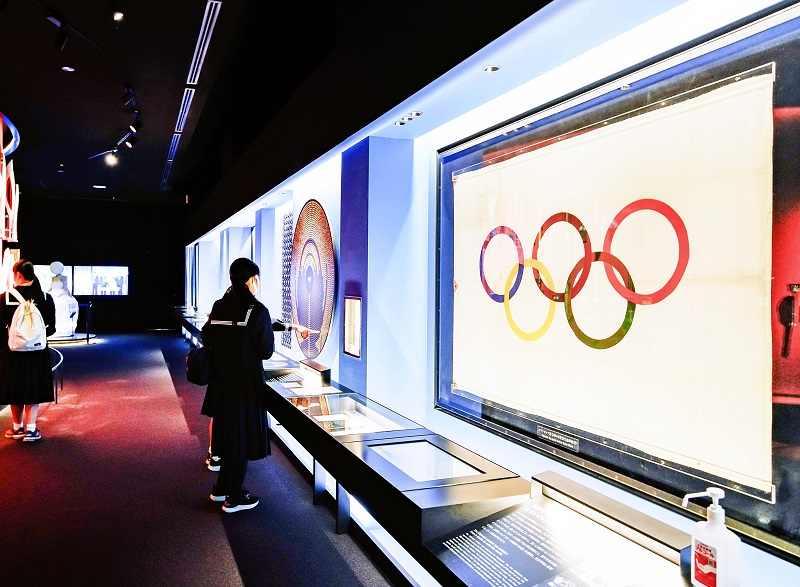
The Olympic flag used during the 1964 Tokyo Olympics is exhibited at the museum.
For example, the exhibition also features items of high historical value, such as the official poster of the 1940 Tokyo Olympics that were never held and later came to be known as the “Missing Olympics,” a model of the planned 100,000-seat Olympic stadium for 1940 at the Komazawa athletic field and the candidature file that Tokyo submitted as part of its bid to win the right to host the 1964 Games.
A device that projects images onto the floor and walls allows visitors to experience the stride and running speed of Usain Bolt and other athletes. It has become popular among visitors as a way to “challenge” Olympic athletes.
Many visitors stop in front of the monitor at the end of the floor, where they can witness the stories of past contestants through a video.
One of the most impressive stories featured in the video is that of Vera Caslavska from Czechoslovakia, a gold medalist in gymnastics at the 1964 Games, who was called a “beautiful flower who bloomed at the Tokyo Olympics.”
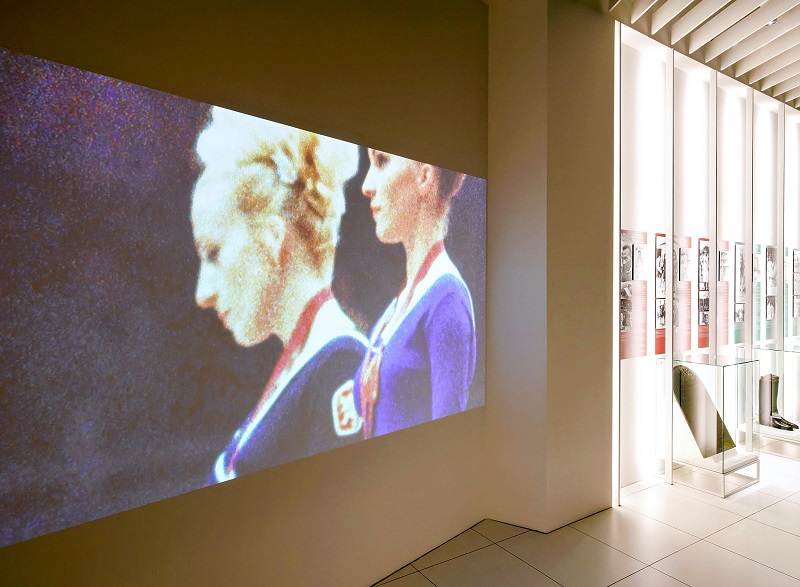
An video story featuring gymnast Vera Caslavska
In 1968, the former communist country in Eastern Europe experienced a democratic movement known as the “Prague Spring,” but the Soviet Union and other countries launched a military intervention.
At the Mexico Games that same year, Caslavska, who tied with a Soviet athlete for the gold medal, turned away at the awards ceremony to protest while the flag was hoisted to the sound of the Soviet national anthem.
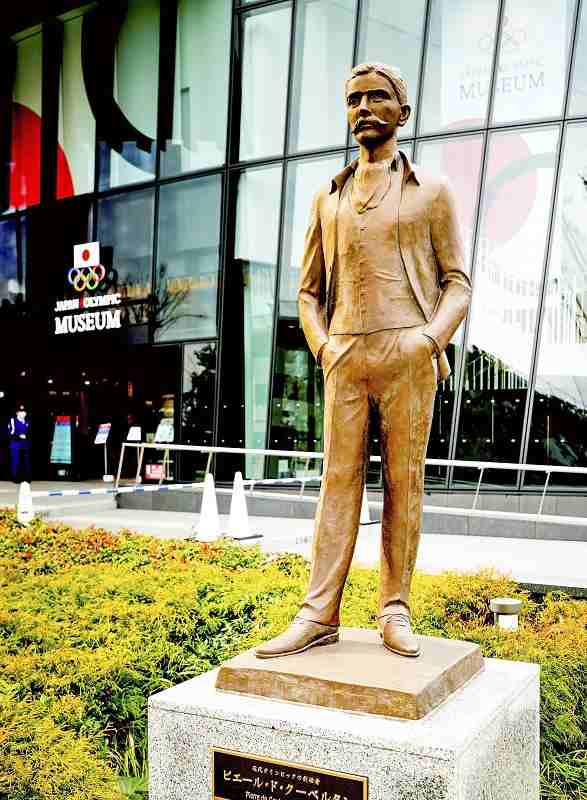
A statue of Pierre de Coubertin, the “father of the modern Olympics”
The museum has five themes: discover, learn, feel, try and think. The anecdotes of past athletes can really help visitors think about the world today.
Japan Olympic Museum
The museum opened in 2019. Yasuhiro Yamashita, president of the Japanese Olympic Committee, is the director of the museum.
Address: 4-2 Kasumigaokamachi, Shinjuku Ward, Tokyo.
Hours: 10 a.m. – 5 p.m. (last admission at 4:30 p.m.). Closed on Mondays (or Tuesday when a Monday falls on a national holiday).
Admission: ¥500 for adults, ¥400 for groups of 20 or more and those aged 65 or older. Free for high school students and younger.
Related Tags
"Features" POPULAR ARTICLE
-
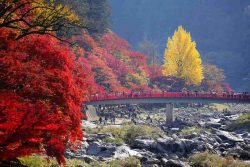
Autumn Foliage Reaches Peak Season at Korankei in Aichi Prefecture
-
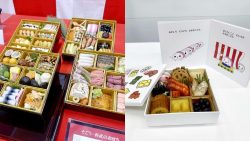
Japan’s Osechi Meals See More Value Offerings as Customers Struggle with Rising Prices
-
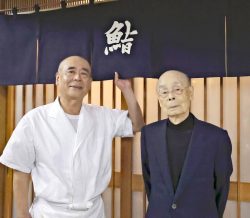
Legendary Sushi Chef Jiro Ono Turns 100: ‘I Have No Regrets’
-

Autumn Foliage Surrounds Visitors to Tokyo’s Showa Kinen Park
-
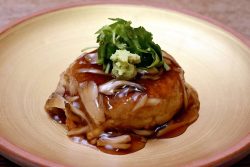
Japanese, Western Flavors Blend in Satoimo Taro Cheese Dumplings; Versatile Seasonal Staple Served with Savory Sauce
JN ACCESS RANKING
-

Govt Plans to Urge Municipalities to Help Residents Cope with Rising Prices
-
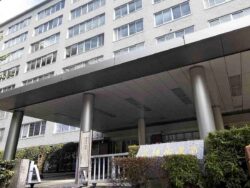
Japan Resumes Scallop Exports to China
-
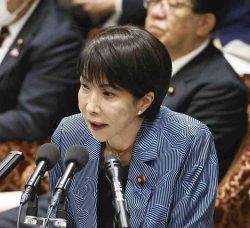
Japan Prime Minister Takaichi Vows to Have Country Exit Deflation, Closely Monitor Economic Indicators
-
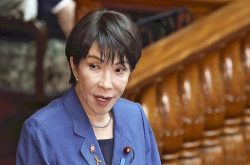
Japan to Charge Foreigners More for Residence Permits, Looking to Align with Western Countries
-
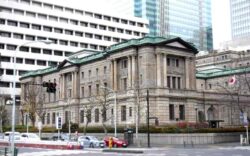
Japan GDP Down Annualized 1.8% in July-Sept.


